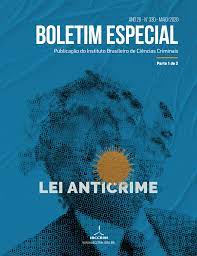Judge of Guarantees: The democratic wave of punishment tide
Views: 238Keywords:
theory of cognitive dissonance, impartiality, Judge of Guarantees, Federal Law 13.964/19Abstract
The article approaches the figure of the Judge of Guarantees, inserted to the Brazilian legal order by the Federal Law 13.964 / 19, discussing about the several aspects related to the theme, among which, the specificities and pertinence of the introduced figure. Thus, the institute was valued from the perspective of the theory of cognitive dissonance, an argument sensitive to the analysis of the subjective impartiality of the judge.
Downloads
Publication Facts
Reviewer profiles N/A
Author statements
- Academic society
- Instituto Brasileiro de Ciências Criminais
- Publisher
- IBCCRIM
References
(1) GIL, Renata. Nota Pública – Juiz de Garantias. AMB, Brasília, 27 dez. 2019. Disponível em: <https://bit.ly/2T1gQ4y>. Acesso em: 05 jan. 2020.
(2) TAFARELLO, R. F. Juiz das garantias: um notável (e atrasado) avanço democrático para o Brasil. Estadão, São Paulo, Disponível em: https://bit.ly/2ZQT2BS . Acesso em: 05 jan. 2020.
(3) CPP: Art. 83. Verificar-se-á a competência por prevenção toda vez que, concorrendo dois ou mais juízes igualmente competentes ou com jurisdição cumulativa, um deles tiver antecedido aos outros na prática de algum ato do processo ou de medida a este relativa, ainda que anterior ao oferecimento da denúncia ou da queixa (arts. 70, § 3º, 71, 72, § 2º, e 78, II, c).
(4) MONTERO AROCA, Juan. et al. Derecho jurisdiccional III: proceso penal. 10. ed. Valencia: Tirant lo Blanch, 2001. p. 29.
(5) POZZEBON, Fabrício Dreyer de Ávila. A imparcialidade do juiz criminal enquanto ausência de causas de impedimento ou de suspeição. Revista Direito e Justiça, Porto Alegre, v. 39, n. 1, jan./jun. 2013.
(6) PEREIRA, Merval. Juiz das garantias. O Globo, Rio de Janeiro, 14 jun. 2019. Disponível em: <https://glo.bo/2SVqo0Y>. Acesso em: 02 jan. 2020.
(7) GIACOMOLLI, Nereu José. A fase preliminar do processo penal: crises, misérias e novas metodologias investigatórias. Rio de janeiro: Lumes Juris, 2011. p. 68.
(8) MAYA, André Machado. O Juizado de garantias como fatos determinante à estruturação democrática da jurisdição criminal: O Contributo das Reformas Processuais Penais Latino-Americanas à Reforma Processual Penal Brasileira. Revista Novos Estudos Jurídicos, v. 23, n. 1, p. 78, jan./abr. 2018.
(9) SCHÜNERMANN, Bernd; GRECO, Luís. Estudos de direito penal, direito processual penal e filosofia do direito. São Paulo: Marcial Pons, 2013. p. 205-221.
(10) RITTER, Ruiz. Imparcialidade no Processo Penal. Reflexões a partir da Teoria da Dissonância Cognitiva. 2016. 197 p. Dissertação (Mestrado) - Faculdade de Direito da Pontifícia Universidade Católica do Rio Grande do Sul, PUCRS, Porto Alegre, 2016. p. 93.
(11) LOPES JÚNIOR, Aury; RITTER, Ruiz. A imprescindibilidade do juiz das garantias para uma jurisdição penal imparcial: reflexões a partir da teoria da dissonância cognitiva. Revista Magister de Direito Penal e Processual Penal, Porto Alegre, v. 13, n. 73, p. 12-25., ago./set. 2016. p. 18.
(12) SCHÜNEMANN, Bernd., op. cit., p. 208.
(13) SCHÜNEMANN, Bernd., op. cit., p. 93.
(14) RITTER, Ruiz., op. cit., p. 153.
(15) TARUFFO, Michele. Uma simples verdade: o juiz e a construção dos fatos. trad. Vitor de Paula Ramos. São Paulo, Marcial Pons, 2012. p. 160.
(16) TARUFFO, Michele. Idee per uma teoria dela decisione giusta. Rivista trimestrale di diritto e procedura civile, v. 51, n. 2, p. 315-328, 1997. apud BADARÓ, Gustavo. Epistemologia judiciária e prova penal. São Paulo: Thompson Reuters Brasil, 2019. p. 19.
(17) CORDÓN MORENO, Faustino. Las garantias constitucionales del proceso penal. 2. ed. Navarra: Arazandi, SA, 2002. p. 109.
(18) Vide, por exemplo, a ADI n. 6298, proposta pela AMB e Ajufe: “Haverá aumento de gastos com a solução final - criação de cargos - e aumento de gastos desde logo, com descolamentos de juízes, sem que tivesse havido previsão orçamentária, e, portanto, com ofensa ao art. 169 da CF”.
(19) MACEDO, Fausto. A desconstrução do pacote Moro. Estadão, São Paulo, 7 dez. 2019. Disponível em: <https://bit.ly/2SW1Bde>. Acesso em: 05 jan. 2020.
Downloads
Published
How to Cite
Issue
Section
License
Copyright of published articles belongs to the author, but with journal rights over the first publication and respecting the one-year exclusivity period. Authors may only use the same results in other publications by clearly indicating this journal as the medium of the original publication. If there is no such indication, it will be considered a situation of self-plagiarism.
Therefore, the reproduction, total or partial, of the articles published here is subject to the express mention of the origin of its publication in this journal, citing the volume and number of this publication. For legal purposes, the source of the original publication must be consigned, in addition to the DOI link for cross-reference (if any).


 Português (Brasil)
Português (Brasil)
 English
English
 Español (España)
Español (España)






